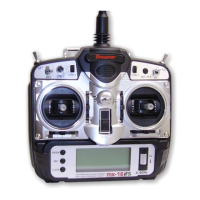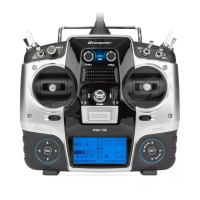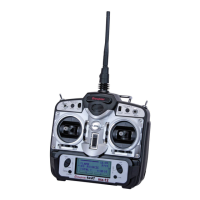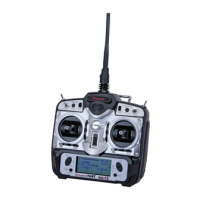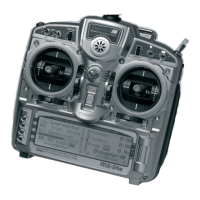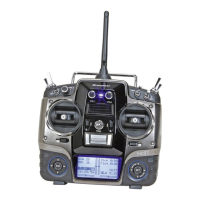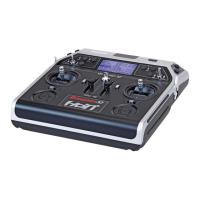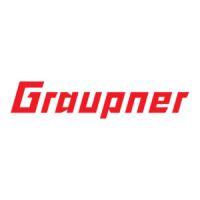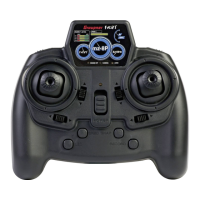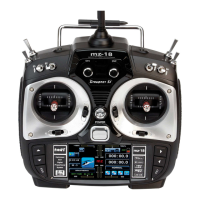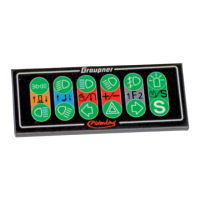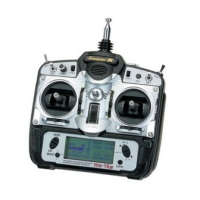
Do you have a question about the GRAUPNER MX-16S and is the answer not in the manual?
| Brand | GRAUPNER |
|---|---|
| Model | MX-16S |
| Category | Remote Control |
| Language | English |
Defines the intended use of the radio control system for models only.
Guides on properly installing the receiver and its aerial for optimal performance.
Provides instructions on how to install servos using vibration-damping grommets.
Explains the importance of accurate, smooth, and free movement of control linkages.
Details essential checks before each flying session for proper system function and range.
Provides safety guidelines for operating models in different environments.
Emphasizes the need to check and recharge batteries regularly for safe operation.
Discusses the need to suppress electric motors to avoid radio interference.
Explains the use of filters for long servo extension leads to prevent de-tuning.
Advises on selecting speed controllers appropriate for the motor size.
Covers interference from ignition systems and proper installation.
Warns about static charges from lightning affecting radio control systems.
Provides guidance on cleaning and maintaining the equipment.
Recommends using only tested and approved components and accessories.
Outlines limitations of manufacturer liability for improper use or installation.
Introduces the mx-16s system, highlighting its features and capabilities.
Details the system's eight-channel digital proportional radio control capabilities.
Lists key hardware features like synthesizer, channel selection, and security.
Describes helicopter menu options for linkage types.
Explains the differences and applications of SPCM and PPM modulations.
Details servo travel adjustment, reverse, and sub-trim capabilities.
Describes the Dual Rate/Expo system for flight characteristic adjustments.
Lists various mixer functions like differential, butterfly, and free mixers.
Explains the programmable Fail-Safe function with hold and preset modes.
Details stopwatch, timer, and model memory copy functions.
Explains the DSC socket for simulators and trainer systems.
Lists technical specifications for the mx-16s transmitter.
Details the technical specifications for the R16SCAN receiver.
Lists optional accessories available for the transmitter.
Identifies a specific replacement part, the telescopic aerial.
Details the transmitter's battery requirements and monitoring.
Explains charging, polarity, and battery removal for the transmitter.
Explains the function and reset of the battery timer display.
Discusses receiver battery types and safety precautions.
Details how to charge the receiver battery, including switch harness use.
Provides general recommendations for safe and effective battery charging.
Lists recommended standard and automatic chargers.
Provides instructions on the proper disposal of batteries.
Explains how to adjust the length of the transmitter sticks for personal preference.
Provides step-by-step instructions for safely opening the transmitter case.
Contains crucial warnings regarding transmitter modification and handling.
Details how to adjust the tension of the stick centring spring.
Explains how to convert sticks between self-neutralising and non-self-neutralising modes.
Describes the procedure for resetting springs to self-neutralising action.
Guides on attaching the neckstrap to the transmitter for balance and comfort.
Highlights the flexibility of assigning transmitter controls to functions.
Explains the versatile function of the DSC socket as an interface.
Lists essential checks and procedures for DSC connection.
Provides a caution regarding battery lead polarization and connector handling.
Emphasizes ensuring all cables are firmly plugged in.
Advises on potential contact swapping for flight simulators.
Warns about receiver battery sockets preventing DSC lead use.
Details the functions of the LCD screen elements and operating buttons.
Explains the battery voltage display and warning system.
Describes Model Name, Memory, Buttons, Modulation, and Timers.
Indicates SPCM mode warnings for voltage, throttle, and trainer errors.
Explains the use of input buttons and function fields on the transmitter.
Describes the function of the ENTER, ESC, and SELECT buttons on the left.
Describes the function of the '+' and '-' rocker buttons and CLEAR button.
Explains how function fields are displayed and selected.
Guides on how to select the transmission channel.
Provides initial notes on PPM, SPCM modes and receiver compatibility.
Stresses the importance of fitting and extending the aerial before powering on.
Details the process of turning on the transmitter and selecting a channel.
Explains how to adjust the LCD screen contrast for readability.
Notes that channels 5-8 are unassigned by default for flexibility.
Guides on setting the receiver channel to match the transmitter.
Describes the supplied receiver and its frequency bands.
Provides steps for binding the receiver to the transmitter channel.
Notes about connecting servos in parallel and diagnostic mode limitations.
Offers suggestions for correct receiver installation in the model.
Crucial safety rule for powering on and off the system.
Details the importance and procedure for range checking before flight.
Defines key terms like control functions, transmitter controls, and channels.
Explains what a control function is in the context of model aircraft.
Defines transmitter controls like sticks and buttons.
Explains function input points and the concept of a control channel.
Defines mixers, switches, and transmitter control switches.
Explains the basic procedure for assigning switches to functions.
Details the special functionality of the SW 4 push-button.
Discusses automatic control switches like G1, G2, G3.
Explains the function of digital trims with visual and audible indicators.
Details the special cut-off trim function for glowplug motors.
Explains specific trim applications for fixed-wing and helicopter models.
Shows how to display INC/DEC button positions.
Describes the visual representation of current servo positions.
Outlines support for various fixed-wing configurations like V-tails and flying wings.
Mentions programmability of Dual Rate and Exponential for control surfaces.
Introduces wing mixers and lists available pre-defined and free mixers.
Provides notes on connecting servos to the receiver outputs.
Details receiver socket assignments for fixed-wing models.
Details receiver socket assignments for Delta/Flying wing models.
Provides a table for correcting servo rotation direction issues.
Discusses helicopter development and the mx-16s capabilities for helicopters.
Explains the helicopter program's support for 1-4 servos.
Notes the inclusion of flight phases and autorotation in model memory.
Mentions DR/Expo and introduces the Heli mixer menu for advanced control.
Highlights changes in channel assignments for older systems.
Provides notes on connecting helicopter servos to the receiver outputs.
Details receiver socket assignments specifically for model helicopters.
Guides on creating and reserving a new model memory.
Warns that functions are barred until model type is confirmed.
Explains the "Throttle too high" warning and its disabling.
Explains how to select, erase, and copy model memories.
Provides steps for securely erasing a model memory.
Notes on throttle warnings, Fail-Safe, and low battery when switching models.
Details the procedure for copying one model memory to another.
Clarifies erasing active vs. non-active model memories.
Outlines essential basic settings for fixed-wing models.
Explains how to enter and display a model name.
Describes the four possible arrangements of control functions on the sticks.
Explains the SPCM and PPM modulation types and selection.
Guides on selecting tail types like normal, V-tail, Delta/flying wing.
Details settings for motor control, idle, and warnings.
Explains aileron/flap configurations and their impact on mixers.
Describes the two timers (stopwatch and flight timer) and their assignment.
Explains the operation of count-up and count-down timers.
Outlines the procedure for setting timer values.
Explains how to set up and name flight phases 2 and 3.
Describes assigning a switch for Trainer mode operations.
Explains how to swap receiver outputs for flexibility.
Lists typical uses for swapping receiver outputs.
Outlines essential basic settings for helicopter models.
Explains model name entry and stick mode selection for helicopters.
Explains SPCM and PPM modulation for helicopters.
Guides on selecting swashplate types based on servo count.
Notes on swashplate mixer ratios.
Explains how to set the main rotor rotation direction.
Details setting the minimum collective pitch for hover and descent.
Notes on C1 trim and throttle limiter function.
Describes the timers and their assignment.
Explains timer operation modes.
Guides on naming and assigning switches for Flight Phase 2.
Explains the Autorotation phase and its switch assignment.
Describes assigning a switch for Trainer mode operations.
Explains receiver output assignment and swapping.
Lists typical uses for receiver output swapping.
Notes on Fail-Safe and receiver output swapping.
Covers servo direction, neutral point, and travel adjustments.
Outlines the basic procedure for adjusting servo settings.
Notes on servo numbering and its relation to transmitter inputs.
Explains how to reverse servo rotation direction.
Details how to adjust the servo travel centre point.
Explains how to adjust servo travel symmetrically or asymmetrically.
Clarifies the direct effect of travel settings on servos.
Explains the basic procedure for assigning switches to functions.
Notes on storing INC/DEC button positions when switching models.
Outlines the basic procedure for assigning controls and switches.
Details the assignment process for controls and switches.
Provides tips for assigning switches and adjusting travel endpoints.
Explains how to adjust transmitter travel symmetrically or asymmetrically.
Clarifies that transmitter travel affects mixer inputs.
Explains control and switch assignment for helicopters.
Notes on storing INC/DEC button positions when switching models.
Outlines the basic procedure for assigning controls and switches.
Details the assignment process for controls and switches.
Provides tips for assigning switches and adjusting travel endpoints.
Explains adjusting transmitter travel for helicopters.
Clarifies transmitter travel affects mixer inputs.
Discusses throttle control assignment for helicopters.
Explains the throttle limit function for helicopters.
Provides notes on throttle limit, speed governors, and gyro gain.
Note on setting the "Lim" function input.
Tip on using Servo display to check throttle limiter influence.
Describes how throttle limit interacts with the C1 trim.
Explains switchable control characteristics for fixed-wing surfaces.
Details how to switch and set Dual Rate values.
Explains the function of Expo for fine control.
Outlines the setup procedure for Dual Rate and Expo.
Warns about minimum Dual Rate values for control.
Shows how Dual Rate and Expo values are superimposed.
Explains how to switch and set Expo values.
Provides examples of different Expo value settings.
Explains switchable characteristics for helicopter controls.
Outlines the setup procedure for Dual Rate and Expo.
Details how to switch and set Dual Rate values.
Explains Expo function for helicopter controls.
Warns about minimum Dual Rate values.
Shows how Dual Rate and Expo values are superimposed for helicopters.
Explains how to switch and set Expo values for helicopters.
Provides examples of different Expo value settings.
Notes on control switch assignment for C1 stick.
Explains how to set trims for different flight phases.
Notes on default phase settings if no switch is assigned.
Lists selectable names for flight phases.
Guides on adjusting trims for selected flight phases.
Explains the fundamental purpose and operation of mixers.
Lists available pre-programmed and free wing mixers.
Notes on camber-changing flaps and input E6/E7.
Outlines the basic procedure for programming mixers.
Explains the concept of mixer neutral point or offset.
Defines default neutral points for mixers.
Explains aileron differential for adverse yaw compensation.
Explains flap differential for reduced flap movement.
Describes mixers for brake function affecting ailerons, flaps, and elevator.
Describes mixer for aileron command affecting rudder.
Describes mixer for aileron signal affecting flaps.
Explains the crow or butterfly setting using brake mixers.
Describes mixer for elevator affecting flaps.
Describes mixer for elevator affecting ailerons.
Describes mixer for flap affecting elevator.
Describes mixer for flap affecting ailerons.
Explains differential reduction for improving aileron response.
Introduces Heli mixers for flight phase-specific control.
Explains the structure and parameters of Heli mixers.
Details setting the collective pitch curve using 5-point curves.
Guides on the detailed procedure for programming Heli mixers.
Shows example collective pitch curves for different flight phases.
Details setting the throttle curve for helicopters.
Provides notes on using the throttle limit function.
Shows example throttle curves for different flight phases.
Explains tail rotor static torque compensation.
Details how to adjust gyro gain.
Provides points for setting up the gyro sensor for maximum stabilization.
Explains the practical procedure for adjusting curves.
Details idle settings and throttle curve application.
Explains using different throttle curves for flight phases.
Guides on the fundamental set-up procedure for helicopter control curves.
Emphasizes persevering with adjustment until hovering is correct.
Describes standard setup and setting up for constant rotor speed during climb.
Provides crucial safety notes before starting the motor.
Details settings for autorotation, a critical safety maneuver.
Explains setting collective pitch curve for autorotation.
Explains throttle curve settings for autorotation.
Explains tail rotor settings for autorotation.
Describes tail rotor mixer adjustments for autorotation.
Introduces pre-programmed and free mixers.
Discusses the three freely programmable mixers.
Defines key mixer parameters: ratio and neutral point.
Explains using a switch channel as a mixer input.
Introduces linear mixers and their programming.
Explains defining the mixer input source.
Explains defining the mixer output destination.
Explains using a switch channel as a mixer input.
Details how to erase a defined mixer.
Explains assigning switches to mixers.
Explains using trim to affect mixer input.
Discusses special features like C1→C1 mixers.
Notes on wing servo assignments and mixer effects.
Notes on helicopter servo assignments.
Guides on setting up linear mixer curves.
Points to Control settings for assigning controls.
Explains setting symmetrical mixer values.
Note on moving mixer neutral point back to center.
Explains setting asymmetrical mixer ratios.
Note on setting up switch channel mixers.
Provides examples for aero-tow release and helicopter collective pitch trim.
Details mixers for collective pitch, roll, and pitch-axis.
Describes mixer functions for HEIM mechanics with two collective pitch servos.
Note on ensuring servos do not strike mechanical end-stops.
Explains Fail-Safe setup specifically for SPCM mode.
Details the programming steps for Fail-Safe settings.
Strong warning against switching off the transmitter during flight to test Fail-Safe.
Guides on programming model data into the transmitter.
Illustrates outboard aileron and inboard flap setups.
Discusses motor and brake system operation for gliders.
Guides through the initial steps of setting up a new model.
Provides a specific example for a non-powered fixed-wing model.
Directs to Select Model and Base Settings menus for initial configuration.
Notes on motor settings, mixer availability, and tail/aileron configurations.
Directs to Servo settings for model adjustments.
Directs to Wing mixers for fine-tuning flight characteristics.
Notes on wing mixer options and setting up the Brake-Aileron mixer.
Explains Brake-Flap mixer settings.
Explains differential reduction for improving aileron response.
Note on using one flap servo and reducing flap travel.
Directs to Dual Rate/Exponential for adjustments.
Guides on integrating an electric power system into the model programming.
Details using rotary control CTRL 7 for electric motor control.
Details using a switch for electric motor ON/OFF control.
Details using a three-position switch for electric motor control.
Explains using C1 stick for motor and crow system control.
Introduces the fourth programming example.
Crucial note on setting motor to "none" and its implications.
Directs to Servo settings and Free mixers for programming.
Explains mixer value adjustment and checking via Servo display.
Explains using C1 stick or switches to operate timers.
Tip on setting stopwatch to count down for electric motor run time.
Guides on programming and switching between flight phases.
Directs to Base settings and Phase trim for phase setup.
Notes on phase naming and display.
Shows how to operate two servos in parallel using Free mixers.
Directs to Base settings and Free mixers for programming.
Points to Control settings for input assignment.
Discusses servo arrangements for modern deltas/flying wings.
Guides on selecting Base settings for deltas/flying wings.
Explains how settings define available wing mixers.
Explains mixer effects on elevator/aileron for deltas.
Notes on elevator/aileron trim for deltas.
Details programming a delta with a normal tail setup.
Directs to Wing mixers and Free mixers for adjustments.
Points to Control settings for disabling inputs.
Introduces F3A models and their characteristics.
Describes ideal F3A model characteristics and primary controls.
Guides on programming F3A models, referring to earlier sections.
Directs to Servo and Base settings for F3A model configuration.
Directs to Control settings and advises on Fail-Safe for SPCM mode.
Directs to Free mixers for programming.
Discusses the effect of mixer values on control precision.
Guides on correcting common model flight errors using mixers.
Addresses rudder commands causing unwanted roll or pitch.
Addresses deviations from ideal lines in vertical climbs and descents.
Discusses rolling tendencies at idle and aileron correction.
Addresses rolling tendencies when ailerons/flaps are extended.
Summarizes settings for expert flyers and advises on gradual refinement.
Introduces the helicopter programming example.
Directs to Select Model and Base settings for helicopter configuration.
Introduces helicopter-specific settings like Swashplate Type and Rotor Direction.
Guides on setting the minimum pitch position.
Directs to Swashplate mixer settings.
Directs to Servo settings for adjusting travels and directions.
Directs to Control settings for throttle limiter.
Directs to Base settings for assigning autorotation switch.
Directs to Heli mixers for helicopter setup.
Tip on managing reference points for collective pitch curve.
Guides on further adjustments for hovering and circuits.
Directs to Base settings for assigning Phase 2 switch.
Guides on modifying settings for Phase 2 in Heli mixer.
Explains how to configure the mx-16s as a student transmitter.
Details using the mx-16s as a teacher transmitter for full control transfer.
Critical note on PPM transmission and DSC lead for student transmitters.
Guides on checking the trainer system functions before use.
Describes trainer mode operations and setup.
Lists available trainer leads and their compatibility.
Lists common errors encountered in trainer mode operations.
Shows the official approval certificate.
Displays the EU conformity declaration.
Lists service centers and hotline information.
Contains the warranty certificate details.
